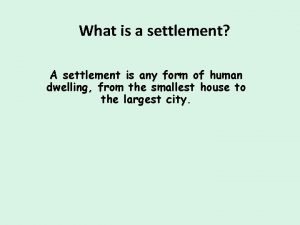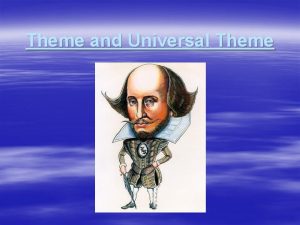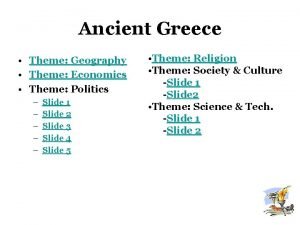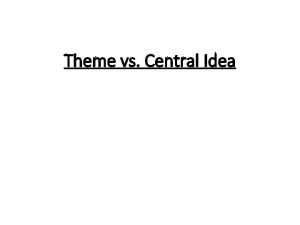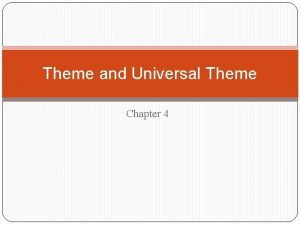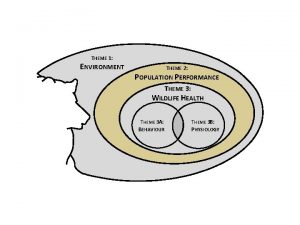Settlement change 1 the example of Manchester Theme





![The urban-rural continuum [definition] Rural-urban continuum, the merging of town and country, a term The urban-rural continuum [definition] Rural-urban continuum, the merging of town and country, a term](https://slidetodoc.com/presentation_image_h/bc86d84dc96fabeeb4296126495b28e7/image-6.jpg)




































- Slides: 42

Settlement change 1 – the example of Manchester

Theme 2 – Investigating Settlement Change in MEDCs Key Question 2. 1 What are the distinctive features of settlements? • The settlement hierarchy/continuum comprising mega-cities, towns, villages and hamlets. • The urban-rural continuum. • The distinctiveness of places – perceptions of places/local areas. Key Question 2. 2 How does the social and cultural structure of settlements vary and why? • Patterns of intra-urban migration leading to ghettoisation and student districts. • The reasons for counter-urbanisation and re-urbanisation. • Social patterns and diversity of life styles that are influenced both by human and physical factors. Key Question 2. 3 What are the issues of the inner city? • The reasons why regeneration is considered appropriate including deindustrialisation, dereliction, wasteland social exclusion and global economic changes. • Evaluation of the success of regeneration schemes in social, economic and environmental terms.

Key Question 2. 4 What are the issues being faced in the CBD? • The issues of access, pedestrianisation, entertainment districts, uniformity of retailing, office districts and transport. • An understanding of the necessity of maintaining/enhancing a vibrant retailing experience in the face of competition from other retail locations away from the CBD and from the Internet. Key Question 2. 5 How is the rural-urban fringe changing and why? • The pressures on green belts from recreation (golf and stadia), retailing and business/office parks and government housing targets, bypasses and ring road developments. • Evaluation of the impact of changes. Key Question 2. 6 How are rural settlements changing and why? • Perceptions of rurality. • The nature of rural settlements and changing rural settlements to include consideration of peripherality, isolation; abandonment; second homes; homes for local employees and retirement; employment; retailing and service provision. • The changing social profile of settlements. • The social impacts of the changing rural economy.

The settlement hierarchy

Hamlet Village - Town – City – Conurbation – Metropolis – Megalopolis - Quotations from The settlement hierarchy a small group of dwellings in the English countryside, usually smaller than a village and lacking a church a cluster of houses lacking local services such as a shop or school a collection of dwelling houses and other buildings, especially in rural surroundings a small rural settlement with few local services, but possibly a post office and primary school in general, a place larger than a village consisting of a compact agglomeration of dwellings, shops, offices, public buildings etc. , usually with paved roads, street lighting, public services, an organised local government and a community pursuing a distinctive urban way of life a large town; an incorporated town that has or had a cathedral; a town on which the dignity has been conferred by tradition or grant a continuously urban area formed by the expansion and consequent coalescence of previously separate urban areas the largest town or agglomeration of people in an extensive area a very large and spreading urban complex, with some open land, formed when built-up areas, widespread over an extensive area, enlarge to such an extent that they become linked together, as in the north-eastern seaboard of the USA, or along the northern shore of the Inland Sea of Japan ‘The Penguin Dictionary of Geography’, A Clark 1990 ‘The Chambers Dictionary’ 1998
![The urbanrural continuum definition Ruralurban continuum the merging of town and country a term The urban-rural continuum [definition] Rural-urban continuum, the merging of town and country, a term](https://slidetodoc.com/presentation_image_h/bc86d84dc96fabeeb4296126495b28e7/image-6.jpg)
The urban-rural continuum [definition] Rural-urban continuum, the merging of town and country, a term used in recognition of the fact that in general there is rarely, either physically or socially, a sharp division, a clearly marked boundary, between the two, with one part of the population wholly urban, the other wholly rural. There is a mix of high density urban areas, suburbs, semi-rural and rural locations in Greater Manchester, but overwhelmingly the land use in the county is urban. 1 City of Manchester 2 Stockport 3 Tameside 4 Oldham 5 Rochdale 6 Bury 7 Bolton 8 Wigan 9 City of Salford 10 Trafford


What makes a place distinctive? Its history – the next few slides will show Manchester is special, and how it has made a contribution to many different fields of human achievement. Manchester was the world’s first industrial city. In the last years of the 18 th century and the start of the 19 th century Manchester provided for the world a model for the emerging industrial society. The city led the world into the modern age.

POLITICS, RELIGION AND SOCIETY The Anti-Corn Law League was the world’s first modern political movement, employing full time administrators, public speakers, lobbying and new technology (the telegraph). The vegetarian movement began in 1809 in Salford, inspired by the Rev. William Cowherd. A vegetarian cookbook was produced in 1812 by Martha Brotherton. Her husband was the first vegetarian MP. Emmeline Pankhurst founded the Suffragettes, campaigning for votes for women, at her home in Manchester in 1903. The first meeting of the TUC (trades Union Congress) was in Manchester in 1868. In October 1945 Manchester hosted the Pan-African Conference. Decisions made here proved to be “a landmark in the history of the African peoples struggle for unity and freedom” according to Jomo Kenyatta, first President of Kenya.

Science and industry John Dalton in 1803 formulated atomic theory, the precursor of modern chemistry, whilst his lectures on meteorology turned the study of weather into a modern science. He was also the first scientist to describe colour blindness. James Joule stated the First Law of Thermodynamics regarding the mechanical equivalence of heat, and he is commemorated by the name of the unit of energy – the joule. Sir Joseph Whitworth (1803 – 1887) was the father of precision engineering, enabling him to make tools with an accuracy of 0. 000001 inch, developing a standard screw thread and a mechanical street cleaner. James Nasmyth invented the steam hammer in 1840. The world’s first purpose built industrial estate was Trafford Park in 1896. Ernest Rutherford at Manchester University discovered how to split the atom in 1919. One of his team was Hans Geiger, the inventor of the Geiger Counter. The first computer with a stored programme and a memory (nicknamed ‘The Baby’) was developed at Manchester University in 1948 by Profs. Tom Kilburn and Fred Williams. Dr Thomas Percival in the late 18 th century founded the science of medical ethics. In 1904 the Hon. Charles Rolls met Henry Royce in the Midland Hotel to form the famous company making cars and aero-engines. The University of Manchester has produced 20 Nobel prize winners. Professor Bernard Lovell pioneered the study of radio astronomy, being responsible for the building of the large radio telescope at Jodrell Bank, about 20 miles away.

Transport The first modern canal in Britain was the Bridgewater Canal built in 1764, a totally artificial waterway independent of natural rivers. The world’s first railway connecting two cities started operating from Liverpool Road station in February 1830. It was the success of this railway that started the railway revolution. The first mechanically powered submarine was launched in 1880 to the design of a curate from Hulme, Rev. George Garrett. The world’s first and only swing aqueduct is at Barton, taking the Bridgewater Canal over the Manchester Ship Canal, together with 800 tonnes of water. It was built in 1893. Former Manchester Central High School students J. W. Alcock and A. W. Brown were the first to cross the Atlantic Ocean by aeroplane non-stop in 1919. Manchester established the world’s first municipal airport in 1929. Trams were first re-introduced onto British streets through Manchester’s Metrolink service in 1992.

Arts The Hallé Orchestra is a professional permanent orchestra set up by the German conductor Sir Charles Hallé. It now has a home in the purpose built Bridgewater Hall in Central Manchester. Ann Horniman began British repertory theatre in 1908 at the Gaiety theatre. The first broadcast of ‘Top of the Pops’ was from a former chapel in Dickinson Road, Rusholme in 1964. The Rolling Stones and Hollies headlined. Roget’s ‘Thesaurus of English Words and Phrases’ was compiled by Peter Mark Roget as an aid for people needing synonyms whilst working as first secretary of Manchester’s Portico Library in the early 19 th century. Coronation Street, produced by Manchester based Granada TV, is the longest continuously running TV soap opera in the world, having been first broadcast in 1960. Manchester’s influence on pop music has been immense, from the Hollies, Freddie and the Dreamers and Herman’s Hermits in the 1960 s, to 10 cc, Roy Harper, Barclay James Harvest and Elkie Brooks in the early 1970 s, to the punk band the Buzzcocks and the fall in the late 1970 s. The 1980 s saw Joy Division and New Order, whose 12” single ‘Blue Monday’ is the biggest selling ever. Also at this time were The Smiths, Carmel and Simply Red. The 1990 s saw the rise of the Hacienda Club, the Stone Roses and Happy Mondays, and later in the decade, Take That and Oasis. Manchester’s clubbing scene is very diverse and cutting edge.

Sport The world’s first professional football league was established in 1888 in the Royal Hotel, Piccadilly. The city is now home to the footballers’ trades union the Professional Footballers’ Association. Manchester United were the first English club to win the European Cup in 1968, and in 1999 became the first to win the European Cup, FA Cup and League Championship in the same year. The largest ever crowd at an English club match was at Maine Road in 1934 when 84, 569 saw Manchester City beat Stoke City. They now play at the Cit of Manchester stadium in Eastlands, capacity 48, 000. Lancashire County Cricket Club has been one of the most successful, producing a host of great players, most recently Andrew (Freddie) Flintoff. Manchester Storm ice hockey team play at the MEN Arena, the largest indoor arena in Europe. In rugby union Sale Sharks are one of the top Premiership teams, whilst in rugby league Wigan Warriors are just down the road. Manchester’s velodrome is a record breaking track for cycling events. Manchester held the Commonwealth Games in 2002 in a purpose built stadium now used by Manchester City.

Civic achievement Manchester Corporation Gas, the first company of its kind in the country, producing town gas from coal, was set up in 1818 at a cost of £ 40, 000. Philips Park, Queens Park and Peel Park opened in 1846 to become the first municipal parks. Manchester led the way in providing the citizens of the big new cities with a supply of fresh pure water when it opened its Longdendale Reservoirs in the Lake District in 1851. Salford Borough Library opened in 1850, followed by Manchester in 1852. Manchester operated the first Children’s Library from 1862. The nation’s first free public library was Chetham’s Library, opening in 1653.

The name Manchester gives us a clue as to the origins of this great city. Cities with `Chester' as part of the name usually date from the Roman era. The Roman name for Manchester was Mamucium or Mancunium. It was the site of a fort and minor settlement in those days, built on the main road linking the legionary fortresses of Chester and York, at a cross-roads where it met the main North South highway between Buxton and Lancaster. The site, known as Castlefield, is near the confluence of the Rivers Irwell and Medlock. Manchester – a history A mural by Ford Madox Brown at Manchester City Hall

A civilian settlement developed outside the fort, firstly to service the military unit, but afterwards as a centre in its own right. After the Roman withdrawal of c. 400 AD the settlement of Mancunium reverted to the Britons and later to the Danes, when they conquered the area and nearly destroyed the settlement in 800 AD. The site of the Roman fort as it is nowadays. An artists impression of the fort at Castlefield.

With the coming of Flemish weavers in 1363 Manchester’s history as a textile town started. When the Anglo-Saxons ruled the area, the main settlement was no longer at Castlefield, but had moved to the confluence of the Irwell and the River Irk, an area known as Hunts Bank. By the time of the Domesday Book in 1086, Manchester had a population of about 3, 000. Various charters were granted in the 13 th and 14 th centuries. Henry III granted a charter in 1227 allowing a three-day fair to be held annually, and another charter granted in 1301 allowing the citizens to elect a mayor. However Manchester was still little more than a market town.

During the 16 th and 17 th centuries Manchester grew from being a medieval village because of its development as a commercial centre (centre of trade - buying and selling) and the growing importance of the textile industry (mostly cotton). The 17 th century saw fatal epidemics hit Manchester, with 1, 000 dying in the 1605 plague, and another outbreak in the town in 1645. By 1717 the population had grown to around 8, 000 and by 1773, a census showed a population of 22, 481 in 3, 402 houses (an average of 6. 6 persons per house). During the Civil War Manchester declared for Parliament against the King and was besieged by the Royalist army. The siege was relieved after a few days conflict.

The 18 th century saw the evolution of a transport network in the form of canals. Boats would sail from Liverpool to Manchester, exchanging raw materials for manufactured goods. Manchester was on a higher level of the industrial process than Liverpool. By 1800 Manchester was at the centre of a network of canals stretching from London to Lancaster, and from Liverpool to Hull. Manchester's population was now 70, 000. Factories and housing was spreading westwards towards the River Irwell, and the Georgian grid pattern of streets expanded. The first major canal in the area was the Bridgewater canal, completed in 1764.

The Industrial Revolution was of great importance to Manchester. It experienced a period of rapid growth during the 19 th century, with the population growing from 70, 000 in 1801 to 544, 000 in 1901. Conditions were dreadful in the early years of the 19 th century. Over half of the population of 1835 lived in cellars in extremely squalid conditions. Gradually improvements were made and the worst sort of housing (called back-to-backs) were outlawed.



Cottonopolis is a name given to the city of Manchester, in England. First bestowed during the 19 th century, it denotes a metropolis of cotton and cotton mills, as inspired by Manchester's status as the international centre of the cotton and textile processing industries during this time. It wasn’t just the manufacturing of cotton that established Manchester’s reputation. There were thousands of warehouses and the finance and commerce sectors also developed.

Friedrich Engels Together with Karl Marx Friedrich Engels wrote ‘The Communist Manifesto’, one of the most famous political books ever written. Before this however, in 1845, he had written ‘The condition of the working class in England’ in which he described the extremely poor working and living conditions of the mill workers in Manchester. He brought to the attention of social reformers the need for change and improvements in people’s lives and opportunities.

The Liverpool to Manchester railway In 1830 the first major passenger railway between two cities was completed between Liverpool and Manchester by George Stephenson. His engine, the Rocket, became world famous. The railway enabled raw materials to be transported easily from the docks in Liverpool to the factories in Manchester, and for finished goods to be exported from Liverpool to the British Empire.

The Peterloo Massacre occurred on August 16. 1819 when a large of peaceful unarmed crowd of 60, 000 – 80, 000 was dispersed violently by a force of troops and local militia. The meeting had been organised by the Manchester Patriotic Union Society, a political group that agitated for radical parliamentary reform and the repeal of the corn laws. Eleven people were killed and about 500, including 100 women, injured, many trampled by horses. One man had his nose severed, and others were bleeding from numerous sabre cuts. Many of those present, including local masters, employers and owners were horrified by the carnage. Although the government supported the actions of the militia the widespread public anger at the massacre swelled the support of the reform movement from which the Chartists would eventually emerge.

Elizabeth Gaskell A still from the recent TV production of ‘North and South’. Elizabeth Cleghorn Gaskell (née Stevenson; 29 September 1810 – 12 November 1865), often referred to simply as Mrs. Gaskell, was an English novelist and short story writer during the Victorian era. She is perhaps best known for her biography of Charlotte Brontë. Her novels offer a detailed portrait of the lives of many strata of society, including the very poor, and as such are of interest to social historians as well as lovers of literature. She settled in Manchester after marriage and several of her books are set in the area.



The first council housing was built in the city in 1889, all housing being privately owned or rented before this time. Much more followed especially in the years following World War I, and again following World War II. A large council estate was built out at Wythenshawe which eventually housed c. 100, 000 people. (Above) The large suburban council estate of Wythenshawe near Manchester Airport. (Left) Victoria Square is still run as municipal housing in the inner city area of Ancoats.

Manchester's economy received an important boost in 1894 when the Manchester Ship Canal was completed, linking Manchester with the sea for ocean-going ships. This meant that Manchester was no longer dependent on Liverpool off loading goods from ocean-going ships and onto those which could negotiate the small canals to the city. The canal was much bigger than the Bridgewater Canal and Manchester truly became a port city with its opening. Nowadays no ships are to be seen along its waters as large container ships dock at purpose built ports elsewhere.


Bomb damage was extensive in World War II, and the city council used this as an opportunity to clear many of the worst slums (slum clearance removed some 83, 000 homes between 1955 and 1980) replacing them with lower housing density modern buildings. High-rise flats were seen as the answer to the city's housing problems at this time. The population of Manchester, which had peaked in 1931 at 766, 000, dropped consistently over the years, and now stands at about 400, 000. This can be explained by the movement of people to outlying areas of the conurbation outside of the city limits (suburbanisation), and also to the growing tendency for people to move back to country areas (counter-urbanisation).

The suburbs and the impact of the motor car Suburbs developed during the first half of this century as transport, especially that of the tram, bus and car improved, and houses for city workers could be built further away from the city centre. The suburbs were favoured by the middle classes, and so semi-detached houses are more common here than the terraces of the inner city. Their layout was often based on the `garden city' approach, and so tree-lined avenues and crescents are common as are gardens and open green spaces such as parks.


Urban sprawl Nowadays of course cars are far more common, and the journey to work presents problems of the rush hour, traffic jams and delays. Cities have had the tendency to sprawl further and further out into the countryside. To stop this land around the outskirts of the city has been designated as green belt land, and houses are not allowed to be built here.

The city has had to develop its policies on transport as the roads become more and more clogged. Motorways surround the city outskirts, forming a ring-road. Inner city urban motorways and dual carriageways have also been built to enable traffic to get from one side of the city to another, forming an inner ring-road. Part of this, called the Mancunian Way, has had to be built on stilts to save on space. Several outlying towns or suburbs have had bypasses built to ease rush-hour traffic. A rapid-transit system of trams has also been developed. Lines extend to the north and south of the city at present and there are plans for expansion of this system. Many multi-storey car parks are to be found in the CBD. As yet however park and ride schemes have not been developed as with other towns such as Chester.

Didsbury A typical Manchester suburb is Didsbury. In contrast to most of the city's wards (and especially Moss Side which had lost 27% of its population in the period 1981 -1991) its population was rising between 1981 and 1991, a rise of 1. 9%. The number of young people was below the city average, and of elderly people, above average. Fewer residents came from ethnic minorities than the city average, and there were fewer single-parent households than elsewhere. Over 70% of households owned a car, many people worked in professional or managerial jobs, and most people owned their own homes. Unemployment was low compared to elsewhere.

Change beyond the city (commuters and villages surrounding the city) Not only the city has been changing over time. Change in the city has caused changes in the rural areas surrounding the cities, often to a distance surprisingly far from the cities themselves. Increased mobility (more cars and better roads) has meant that people can work in the city yet live further and further away from the city. Bangor is only 2 hours drive from the centre of Manchester, so quite a few commuters live in North East Wales within just an hour's drive of the city.

With the establishment of a green belt, housing developments have had to `leapfrog' over the green belt to small towns and villages surrounding Manchester. Depending on the type of houses built, these settlements may be aimed at different groups of people. Poynton, for instance is renowned for being a very expensive and `posh' place, whilst Wilmslow is seen as more down-market. This area surrounding the green belt is known as the commuter belt.

To discourage the continued growth of commuting, some towns are being targeted to provide jobs within the commuter belt itself, or even further afield in remoter rural areas. They are called growth poles. An example of a growth pole closer to Manchester is the airport. It is now the 14 th busiest international airport in the world, and draws much passenger and freight traffic each day, as well as the many workers who work in its terminals, hotels, factories and warehouses.

Out-of-town shopping Other examples of change on the centres rural-urban fringe is of large Trafford Centre commercial and industrial developments. Huge out-of-town shopping centres, e. g. Trafford Centre, or Cheshire Oaks further afield, draw upon a huge catchment area. They need to be built very close to motorways to enable the customers to reach and leave the development quickly. Industrial estates, warehouses and distribution centres have also been built in such accessible locations. Many are to be found on the M 6/M 56 and M 6/M 62 junctions. Here goods can be distributed nation-wide with the greatest of ease, a situation very different to the congested inner city.
 Differential manchester encoding
Differential manchester encoding Dispersed settlement
Dispersed settlement Hình ảnh bộ gõ cơ thể búng tay
Hình ảnh bộ gõ cơ thể búng tay Lp html
Lp html Bổ thể
Bổ thể Tỉ lệ cơ thể trẻ em
Tỉ lệ cơ thể trẻ em Gấu đi như thế nào
Gấu đi như thế nào Glasgow thang điểm
Glasgow thang điểm Bài hát chúa yêu trần thế alleluia
Bài hát chúa yêu trần thế alleluia Môn thể thao bắt đầu bằng chữ f
Môn thể thao bắt đầu bằng chữ f Thế nào là hệ số cao nhất
Thế nào là hệ số cao nhất Các châu lục và đại dương trên thế giới
Các châu lục và đại dương trên thế giới Công thức tính thế năng
Công thức tính thế năng Trời xanh đây là của chúng ta thể thơ
Trời xanh đây là của chúng ta thể thơ Cách giải mật thư tọa độ
Cách giải mật thư tọa độ Phép trừ bù
Phép trừ bù Phản ứng thế ankan
Phản ứng thế ankan Các châu lục và đại dương trên thế giới
Các châu lục và đại dương trên thế giới Thể thơ truyền thống
Thể thơ truyền thống Quá trình desamine hóa có thể tạo ra
Quá trình desamine hóa có thể tạo ra Một số thể thơ truyền thống
Một số thể thơ truyền thống Cái miệng bé xinh thế chỉ nói điều hay thôi
Cái miệng bé xinh thế chỉ nói điều hay thôi Vẽ hình chiếu vuông góc của vật thể sau
Vẽ hình chiếu vuông góc của vật thể sau Thế nào là sự mỏi cơ
Thế nào là sự mỏi cơ đặc điểm cơ thể của người tối cổ
đặc điểm cơ thể của người tối cổ Giọng cùng tên là
Giọng cùng tên là Vẽ hình chiếu đứng bằng cạnh của vật thể
Vẽ hình chiếu đứng bằng cạnh của vật thể Tia chieu sa te
Tia chieu sa te Thẻ vin
Thẻ vin đại từ thay thế
đại từ thay thế điện thế nghỉ
điện thế nghỉ Tư thế ngồi viết
Tư thế ngồi viết Diễn thế sinh thái là
Diễn thế sinh thái là Dạng đột biến một nhiễm là
Dạng đột biến một nhiễm là Số nguyên tố là số gì
Số nguyên tố là số gì Tư thế ngồi viết
Tư thế ngồi viết Lời thề hippocrates
Lời thề hippocrates Thiếu nhi thế giới liên hoan
Thiếu nhi thế giới liên hoan ưu thế lai là gì
ưu thế lai là gì Hổ sinh sản vào mùa nào
Hổ sinh sản vào mùa nào Khi nào hổ mẹ dạy hổ con săn mồi
Khi nào hổ mẹ dạy hổ con săn mồi Hệ hô hấp
Hệ hô hấp Từ ngữ thể hiện lòng nhân hậu
Từ ngữ thể hiện lòng nhân hậu

